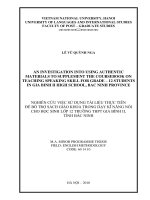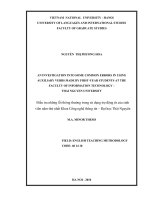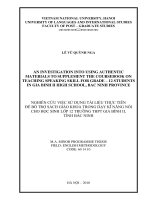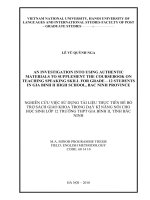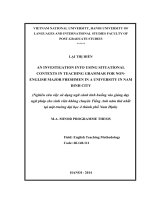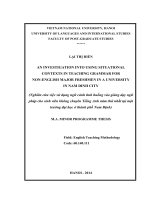An investigation into using peer feedback in project based learning for eighth graders in danang lower secondary schools
Bạn đang xem bản rút gọn của tài liệu. Xem và tải ngay bản đầy đủ của tài liệu tại đây (692.85 KB, 76 trang )
UNIVERSITY OF DANANG
UNIVERSITY OF FOREIGN LANGUAGE STUDIES
THE UNIVERSITY OF DANANG
UNIVERSITY OF FOREIGN LANGUAGE STUDIES
FACULTY OF FOREIGN LANGUAGE TEACHER
EDUCATION
TRAN THI NGOC TUYET
AN INVESTIGATION
USING
AN INVESTIGATION
INTO THEINTO
FREQUENCY
OFPEER
PHRASAL
VERBS
USED IN INFORMAL
LETTERS OF PART
2 WRITING
FEEDBACK
IN PROJECT-BASED
LEARNING
TASK LEVEL B2 PERFORMED BY SECOND-YEAR STUDENTS
FOR EIGHTH GRADERS IN DANANG LOWER
FROM ENGLISH DEPARTMENT AT UNIVERSITY OF
SECONDARY SCHOOLS
FOREIGN LANGUAGE STUDIES – THE UNIVERSITY OF
DANANG
RESEARCH
PROPOSAL
MASTER THESIS
MAJOR: ENGLISH LINGUISTICS
RESEARCH PROPOSAL
Da Nang, 2021
THE UNIVERSITY OF DANANG
UNIVERSITY OF FOREIGN LANGUAGE STUDIES
FACULTY OF FOREIGN LANGUAGE TEACHER
EDUCATION
AN INVESTIGATION INTO USING PEER
FEEDBACK IN PROJECT-BASED LEARNING
FOR EIGHTH GRADERS IN DANANG LOWER
SECONDARY SCHOOLS
Major: English Language Teaching
Code: 8140111
RESEARCH PROPOSAL
MASTER THESIS
SUPERVISOR:
Da Nang, 2021
Contents
CHAPTER 1. INTRODUCTION........................................................................................4
1.1.
RATIONALE............................................................................................................4
1.2. AIMS AND OBJECTIVES...........................................................................................5
1.3. RESEARCH QUESTIONS...........................................................................................6
1.4. SCOPE OF THE STUDY.............................................................................................6
1.5. SIGNIFICANCE/ JUSTIFICATION OF THE STUDY............................................6
CHAPTER 2. LITERATURE REVIEW...........................................................................7
2.1
THEORETICAL BACKGROUND OF PROJECT-BASED LEARNING........7
2.1.1
Definition of Project-Based Learning (PBL).........................................................7
2.1.2
Types of PBL.............................................................................................................8
2.1.3
Principles of PBL......................................................................................................8
2.1.4
Benefits of PBL in English teaching.......................................................................9
2.1.5
Steps for implementing a PBL project.................................................................10
2.2
THEORETICAL BACKGROUND FEEDBACK...............................................13
2.2.1
Feedbacks and Peer feedbacks..............................................................................13
2.2.2
Benefits of Peer Feedback in PBL.........................................................................19
2.2.3
Challenges of Peer Feedbacks in PBL..................................................................21
2.3
PREVIOUS STUDIES...........................................................................................22
CHAPTER 3. RESEARCH METHODS..........................................................................25
3.1
Research design......................................................................................................25
3.2
Participants & sampling........................................................................................25
3.2.1
Participants.............................................................................................................25
3.2.2
Sampling..................................................................................................................27
3.3
Research instruments.............................................................................................28
3.3.1
Student questionnaire............................................................................................28
3.3.2
Teacher interview...................................................................................................29
3.3.3
Classroom observation...........................................................................................30
3.4
Data collection procedures.....................................................................................31
3.5
Data analysis procedures.......................................................................................32
3.6
Validity and reliability...........................................................................................32
3.7
Ethical issues...........................................................................................................32
CHAPTER 4: RESULTS AND DISCUSION..................................................................33
4.1
Thực trạng sử dụng Peer Feedback in Project-Based Learning........................33
4.1.1
Findings from the student questionnaire.............................................................33
4.1.2
Findings from teacher interviews..........................................................................35
4.1.3
Findings from class observations..........................................................................35
4.2
Benefits of using peer feedback in project-based learning.................................36
4.2.1
Findings from the student questionnaire.............................................................36
4.2.2
Findings from teacher interviews..........................................................................41
Improve the classroom atmosphere....................................................................................41
Students can improve their communication skills..............................................................42
Students improve their thinking and criticism...................................................................43
4.2.3
Findings from class observations..........................................................................44
4.3
Challenges of using peer feedback in project-based learning............................45
4.3.1
Findings from the student questionnaire.............................................................45
4.3.2
Findings from teacher interviews..........................................................................48
4.3.3
Findings from class observations..........................................................................52
Chapter V: Conclusions and recommendations..............................................................54
5.1
Conclusion...............................................................................................................54
5.2
Recommend.............................................................................................................55
5.2.1
Advice for teachers.................................................................................................55
5.3
Research limitations and follow-up research directions.....................................61
CHAPTER 1. INTRODUCTION
1.1.
RATIONALE
It is evident that English plays an important role in modern world. With the advance of
globalization, English is not only used in daily life but also an international language in
official communications in economics, business and commerce. More and more people
are studying English as a second language or a foreign language, that is the reason why
improving and enhancing the English teaching methods becomes a remarkable topic of
researchers.
In terms of English language teaching, with the presence of Communicative Language
Teaching (CLT), schools or institutions of secondary education have been making a lot
of attempts to give learners many opportunities to access to communicative learning as
well as develop soft skills including team work, problem-solving (Casner-Lotto &
Barrington, 2006).
However, with the traditional learning and teaching methods,
where teachers are “the transmitter of the knowledge” while students act as “the
receptor of the information” (Alorda, Suenaga, & Pons, 2011, p.1876), it is difficult to
increase learners’ actual target language use for communicative purposes. One
effective way to reach this target is project-based learning (PBL). PBL is a learning
process in which learners participate in individual or teamwork projects to work with
their partners to create the final product. It is shown that PBL had an enormous effect
on students’ academic achievement than teacher’s direct instruction, activating
interactions among learners through collaborative learning, particularly in an Asian
country.
In Vietnam, in recent years, one of significant breakthroughs is the appearance of
lessons “Project” in English textbooks for secondary students with the aim to
promoting the interaction as well as communication in English. Many efforts are made
to integrate communicative language teaching in schools, specifically, in Danang city,
English teachers at secondary schools have been applying positively numerous
approaches through periods about Projects to improve student’s learning. Nevertheless,
one arising challenge English teachers in Danang city are facing is assessing students’
performance through Projects.
In projects for individuals, it is more objective if the teacher along with all students in
class has the right to assess their peers’ product. In projects for team work, launching
an academic project is a long process in which requires the strict cooperation among all
team members, so only teacher’s assessment seems not to be enough. That is the reason
why peer feedback (PF) needs implementing as a means of assisting the process of
assessment effectively and creating a cooperative learning environment. There are
many researches related to the application of peer feedback into developing writing
skill, speaking skill and project-based learning, but mostly for undergraduates at
universities. I recognized that limited attention is paid to secondary students when
considering giving peer feedback in project-based learning. Such reasons have urged
me to carry out this research paper entitled “An investigation into using peer
feedback in project-based learning for eighth graders in DaNang lower secondary
schools” to examine in which way students evaluate their peers in PBL as well as
difficulties of students during the process of using peer feedback and ways to apply
peer feedback in PBL effectively. From the results of this study, the author hopes to
praise the important role of peer feedback in project teaching and learning.
1.2. AIMS AND OBJECTIVES
1.2.1. Aims
This study aims to (i) investigate the application of peer feedback in project-based
learning of the grade 8 students of secondary schools in Da Nang city (ii) identify
difficulties while using peer feedback in team projects for the eighth grade students of
secondary schools in Da Nang city.
1.2.2. Objectives
In order to accomplish the above mentioned aims, these actions below should be
done:
-
Apply peer feedback in PBL for the eighth grade students of secondary schools
in Da Nang city.
-
Identify difficulties while using peer feedback in team projects for the eighth
grade students of secondary schools in Da Nang city.
1.3. RESEARCH QUESTIONS
-
How is peer feedback applied in PBL for the eighth-grade students of secondary
schools in Da Nang city?
-
What are some difficulties students meet when giving peer feedback in PBL?
1.4. SCOPE OF THE STUDY
In the scope of the study, the research is confined to investigating application of
peer feedback in PBL of the eighth grade students at some secondary schools
(FPT, Tay Son, Trung Vuong secondary school) in Da Nang.
1.5. SIGNIFICANCE/ JUSTIFICATION OF THE STUDY
The findings of the research can bring some benefits as mentioned below:
-
Peer feedback can be an effective method of assessment that teachers should
apply into project-based teaching.
-
When implementing giving feedback to assess quality of their fellow
students’ work, students can learn how to support one another as well as
self-assess based on teacher’s criteria.
-
The study can be used as a literature review for those who would like to
do more research into this field in the future.
CHAPTER 2. LITERATURE REVIEW
2.1 THEORETICAL BACKGROUND OF PROJECT-BASED LEARNING
Project-based Learning (PBL) in class reinforces a solid relationship among
teammates as well as stimulates collaboration among students. This is a good chance
for them to talk more, to share their thoughts about the works of peers and to develop
their teamwork skills. One of the useful assessment tools needed in PBL is peer
feedback. Through peer feedback, students have the right to evaluate their mates’ work
as the way the teacher did.
2.1.1 Definition of Project-Based Learning (PBL)
PBL has been defined in many ways. For this reason, there exists no single definition.
PBL is based on the constructivist learning theory, which finds that learning is deeper
and more meaningful when students are involved in constructing their own knowledge.
Constructivism is a theory based on observation and scientific study about how people
learn. People construct their own understanding and knowledge of the world, through
experiencing things and reflecting on those experiences (Vygotsky, 1978). When we
encounter something new, we have to connect it with our previous ideas and
experiences, it may change what we currently know and believe. As we acquire new
information we need to continue to ask questions, explore, and assess what we
currently know.
According to the definition of Ministry of Education of Malaysia, PBL is a model for
classroom activity that shifts away from the usual classroom practices of short,
isolated,
lecturer-centered
lessons.
PBL
learning
activities
are
long-term,
interdisciplinary, student-centered, and integrated with real-world issues and practices.
Vygotsky (1978) also stated that the PBL approach is an “in-depth investigation of a
real-world topic worthy of children’s attention and effort.” Hence, field trips,
experiments, model building, posters, and the creation of multimedia presentations are
sample activities within PBL where students with differing learning styles demonstrate
their knowledge by means of inquiry.
Therefore, the main aim of PBL is an active connection of pupils to educational
process. This process is characteristic of their openness. Problem situations and
questions are created by lectures.
2.1.2 Types of PBL
In designing PBL, the project can be classified into different types or categories. It is as
proposed by Henry, as cited from Sawsan (2014) as follows:
The first one is structured projects. In this case, the teacher determines and organizes in
terms of the topic, materials, methodology and presentation. It has the following
characteristics: the topic is selected by the teacher as well as the methods for collecting
and analyzing the information.
The second is semi-structured project. Accordingly, the project is defined and
organized in part by the teacher and in part by students. The teacher defines the general
topic of the project, but the students have full authority to choose their own topic as
well as the way they accomplish the information and the project.
The last one is unstructured projects. The project is defined and organized largely by
the students themselves. Hence, the students have full authority in terms of choosing
the topic, materials, methodology and presentation.
2.1.3 Principles of PBL
Poonpon (2014) highlighted five important principles of PBL as follows:
PBL projects are central, not peripheral to the curriculum;
PBL projects are focused on questions or problems that drive students to
encounter and struggle with the central concepts and principles of a discipline;
Projects involve students in a constructivist investigation;
Projects are student-driven to some significant degree;
Projects are realistic, not school-like.
2.1.4 Benefits of PBL in English teaching
English has been taught as a foreign language in Vietnam for a very long time.
However, there has been little application of the PBL in teaching. In fact, PBL has
several benefits in second and foreign language settings. Fried-Booth (2002) states that
the process leading to the end-product of project-work provides opportunities for
students to develop their confidence and independence. The students demonstrate
increased self-esteem, and positive attitudes toward learning. Skehan (1998) argues
that this process can help to enhance students’ autonomy especially when they are
actively engaged in project planning. Autonomous learning is promoted when the
students become more responsible for their own learning.
According to Levine (2004), their language skills can be improved. The students
engage in purposeful communication to complete authentic activities - tasks with real
world relevance and utility; they thus have the opportunity to use language in a
relatively natural context and participate in meaningful activities which require
authentic language use. The authentic activities can provide the opportunity for
students to examine the task from different perspectives, enhance collaboration and
reflection, and allow competing solutions and diversity of outcome.
As dealt with in Stoller (2006), PBL provides opportunities for the natural integration
of all four skills of reading, writing, listening and speaking. Another benefit discussed
in the research of Lee (2002) is that the students have enhanced motivation,
engagement and enjoyment because project work progresses according to the specific
context and students’ interests. From a motivational perspective, projects being
authentic tasks are more meaningful to students, increase interest, motivation to
participate, and can promote learning. PBL is said to motivate students as they are
wholly engaged in the learning task. Enjoyment and motivation also derive from the
fact that classroom language is not predetermined, but depends on the nature of the
project.
In addition, PBL can develop many helpful skills for the students. Coleman (1992)
discusses a benefit relating to students increased social, cooperative skills, and group
cohesiveness. Adopting PBL projects in the classroom also helps reinforce social
relationships among team members. PBL enhances collaboration among learners,
between learners and the teacher, as well as between learners and other community
members as well. Thus, PBL provides learners with opportunities to learn collaborative
skills, such as relying on the work of peers and providing thoughtful feedback to peers.
Making students perform concrete tasks in pairs and groups is common for foreign
languages training; this practice stimulates cooperation and knowledge exchange
amongst students and it encourages individual students to talk more.
Allen (2004) presents the benefits of PBL pertaining to the development of problemsolving and higher order critical thinking skills. These skills are very important, since
they are life-long, transferable skills to settings outside the classroom. This means that
PBL is an innovative approach that employs a different mode of assessment. Utilizing
the PBL approach, learners evaluate themselves continuously. Assessment is seen as an
ongoing, varied and frequent process involving teacher assessment, peer assessment,
self-assessment, and reflection. To put in a nutshell, PBL is very beneficial to students
in general and those of English in particular. The question here is what the teacher and
students do to maximize the benefits of PBL.
2.1.5 Steps for implementing a PBL project
As in Stoller’s research (2009), the benefits of PBL can be maximized when the
teachers and students follow the ten-step process of implementing project work. The
ten steps are summarized as follows:
Step 1: Students and teacher agree on a theme for the project.
At this step, the students and teacher reach a consensus on a project theme. The
projects range from structured, semi-structured, to unstructured in terms of the degree
to which the teacher defines the project; the teacher therefore should work out the ways
in which students can develop some sense of ownership toward the project.
Step 2: Students and teacher determine the final outcome of the project.
The students and teacher come to a decision about the final outcome of the project,
e.g., bulletin board display, written report, debate, brochure, letter, handbook, oral
presentation, video, multimedia presentation, and theatrical performance. They also
negotiate the most appropriate audience for their projects, e.g., classmates, other
students, parents, program director, a local business.
Step 3: Students and teacher structure the project.
After the theme and final outcome of the project are defined, the students and teacher
figure out project details that guide students from the opening activity to the
completion of the project. At this step, students consider their roles, responsibilities,
and collaborative work groups. After negotiating a deadline for project completion,
students arrange the timing for gathering, sharing, and compiling information, and then
presenting their final project.
Step 4: Teacher prepares students for the demands of information gathering
The language, skill, and strategy demand associated with information gathering should
be provided. As the teacher is aware of student ability levels, he prepares instructional
activities for each of the information-gathering tasks. Take English students for
example, if they will be conducting interviews to gather information, the teacher may
plan activities in which students have to form questions, ask follow-up questions,
request clarification, and take notes. If they are expected to write business letters in
English, the teacher might review the format and language of formal letters. If they
intend to conduct an Internet search, the teacher may review search procedures, how to
evaluate an official website, and introduce useful note-taking strategies.
Step 5: Students gather information.
After practicing the skills, strategies, and language needed for gathering information,
the students can readily collect information using methods such as interviewing,
questionnaire, letter writing, and library searches. Whenever possible, the teacher
provides relevant content resources to get students started on their information search.
Step 6: Teacher prepares students to compile and analyze data.
At this step, the teacher should help the students master the language, skills, and
strategies needed to compile, analyze, and synthesize the information that they have
collected from different sources. The instruction for the teacher depends on the types of
information collected and the ways in which it was collected, e.g., taped interviews,
brochures received in response to solicitation letters, library research, and note-taking.
Step 7: Students compile and analyze information.
The students compile and analyze the gathered information. They work in groups,
organize information and then discuss the value of the data that they have collected,
keeping some and discarding others. They have to identify information that is critical
for the completion of their projects.
Step 8: Teacher prepares students for the language demands of the final activity
The teacher designs language-improvement activities to help students successfully
present the final outcome of the project. The activities may focus on skills for
successful oral presentations, effective written revisions and editing, persuasive
debates, and others. The students should focus on form at this point.
Step 9: Students present the final product.
The students present the final outcome of their projects, as planned in the second step.
Step 10: Students evaluate the project.
The students reflect on the language mastered and the subject matter acquired during
the project. They are also asked to make recommendations that can be used to enhance
similar projects in the future. The teachers provide students with feedback on their
language and content learning. With the ten steps to be carefully followed, the benefits
of PBL can be at most yielded by both students and teachers.
2.2 THEORETICAL BACKGROUND FEEDBACK
2.2.1 Feedbacks and Peer feedbacks
2.2.1.1 Definition of feedbacks
There are many definitions about feedback that have been used by researchers. Orrell
(2006) stated that feedback is an essential component in the learning and explains the
gaps in knowledge and understanding, providing for reflection and development.
Feedback at its best is pivotal in the learning and assessment process. Carless & Boud
(2018) also agreed that peer assessment is a process in which students evaluate or are
evaluated by their peers with an aim to enhancing their work or learning strategies.
Feedback in higher education must be concerned with developing new ways of
knowing (Lea and Street 1998) and the popular view is that feedback must explicitly
address future activity, that is, feed-forward rather than feedback (Gibbs and Simpson
2004; Torrance 1993).
2.2.1.2 Types of feedbacks
Nelson and Schunn (2009) identify three broad types: motivational where the intention
is to influence the beliefs of the learners and their willingness to participate in the
learning activities, reinforcing where the aim is to reward or to punish and
informational where the aim is to change the performance of the learners.
Federation University of Australia published an article in the category “Learning and
Teaching”. They mention a range of feedback types including formal, informal,
formative, summative, student peer, student self, constructive feedback.
2.2.1.3 Definition of peer feedbacks
Feedback provided by equal-status learners, called peer feedback, can be a solution to
meet students’ needs of receiving frequent feedback to help them improve their
learning process (Gielen, Peeters, Dochy, Onghena, & Struyven, 2010). KU Leuven
research and educational institution defines peer feedback that feedback is given by
one student to another, through comments made on each other’s work, behavior or
performances. Students will do this based on a prior set of evaluation criteria. When it
comes to Communicative Language Teaching, Liu & Carless (2006) stated that peer
feedback refers to “a communication process through which learners enter into
dialogues related to performance and standards” and can be considered as a form of
collaborative learning
2.2.1.4 Types of peer feedback
This section describes the different types of feedback: positive and negative feedback,
direct and indirect feedback, text-based feedback, and general feedback. Types of
feedback will be discussed, and similarities and differences will be compared, in
particular, the advantages and disadvantages of each type compared with others will be
emphasized.
Positive feedback and negative feedback
A great deal of research has been done on the effectiveness of positive feedback and
negative feedback on students' homework correction. In their research paper,
Hedgecock and Lefkowitz (1994) recognized that students remember and appreciate
positive comments. However, Fathman and Whalley (1990) believe that even positive
comments can greatly help students improve their writing skills. According to Ellis
(1994), this result usually comes from students' motivation to adhere to language skills.
They feel motivated to write more and more when others compliment them for doing
the right job. However, positive comments alone are not enough to promote students'
writing ability (Cardelle and Corno. 1992), because "too much praise can lead to self-
coding, confusion, misleading thinking or failure to motivate students". In 2001,
Helander also suggested being very careful when giving positive praise. According to
these scholars, it is better for students to comment seriously than to praise excessively.
In addition, they pointed out that negative comments or criticisms are more helpful to
students when they want to emphasize the writer's outstanding problems. However, if
too much negative criticism is used, it will sometimes have the opposite effect.
Because when they reread their articles, there are too many negative criticisms,
students will feel disappointed and frustrated, and they will not even correct their
mistakes again. To sum up, it is best to strike a balance between praise and criticism,
because if the two are combined, the article will work best (Ferris and Hedgcock. 1998.
p128)
Direct feedback and indirect feedback
Direct feedback is when the reviewer points out the mistakes and gives suggestions for
correction. Indirect feedback is that commentators only point out mistakes, but do not
correct them. Indirect feedback can take many forms, such as underlining redundant
words or phrases and adding missing words … For direct feedback, students only need
to correct mistakes according to your suggestions. However, in indirect feedback, the
reviewer will only give the mistakes, and students must correct their mistakes. Indirect
feedback can be accomplished by underlining, circling or using different symbols. In
his research paper, Ferris (2002) noted that "indirect feedback is more helpful to
students in many cases because of the greater perceptual cohesion between the
responder and the feedback recipient. Because readers only make mistakes, writers
must find ways to correct their own mistakes. In the long run, this will help stimulate
students' ability to reflect and edit their own articles. In addition, when they have to
correct their own mistakes, students may remember their mistakes longer, so they can
avoid repeating them next time. Contrary to the concept of "indirect feedback," this is
direct feedback in which the multiplier always corrects his friend's mistakes. Scholars
Bartram and Walton (1991) criticize direct feedback as discouraging students'
creativity and independence (p. 26) because writers can do nothing about their
mistakes. Instead, students only need to transfer the error correction parts corrected by
critics to their articles. However, there are some advantages to using direct feedback.
For students with low language proficiency, reviewers should give direct feedback on
complex mistakes, because if they don't suggest how to correct mistakes, weak students
can't know how to correct their homework mistakes.
Specific feedback and general feedback.
According to Ferris and Hedgecock (1998), specific reactions are those that are
"directly related to the text at hand", while broad reactions are those that "may be
related to any article" (P.133). On the question of concrete feedback or generalized
feedback, it seems that concrete feedback brings more benefits to students than
generalized feedback. Because specific comments will correctly point out. Therefore, it
is suggested that the feedback should be "specific enough so that students can
recognize and change their writing" (Reid, 1993, p. 218). However, general feedback is
also essential because students also need to have an overview of their essays. To sum
up, it is necessary to combine general feedback with specific feedback to bring the best
effect to students' writing.
2.2.1.5 Peer feedbacks in Project-Based Learning
In the context of project-based learning, peer feedback requires students to work
together in pairs or teams, depending on the required projects; therefore, using peer
feedback in PBL is considered as cooperative learning. Peer feedback has the potential
to facilitate learning processes in different ways. Evaluating their friends’ project may
help learners reflect on their work and improve their own project performance.
Furthermore, in project-based learning, students can have the opportunity to give
feedback to teammates about the behavior, contribution and motivation in teamwork
activities. Lu and Law (2011) studied peer feedback activities to support high school
students’ project-based learning and examined the effects of different types of peer
feedback assessment on student learning including cognitive and affective feedback.
Cognitive feedback targets the content of the work and involves summarizing,
specifying and explaining aspects of the work under review. When assessors give
cognitive feedback, they summarize arguments, identify problems, offer solutions, and
explicate comments. Affective feedback targets the quality of works and uses affective
language to give praise and criticism or uses non-verbal expressions.
In the setting of English classrooms for secondary schools in VietNam, especially in
project periods, students also attend peer feedback activities, but they meet arising
difficulties. First of all, students don’t know how to give feedback properly, lack
confidence in whether they can provide specific and qualified feedback. In terms of
language use, they even utilize their mother tongue to give feedbacks. Second, students
don’t quite trust peer feedback. Students worship teacher’s authority and rely on
teacher’s commentary, and they are skeptical about peers’ ability to give feedback,
especially peers they consider as lower competence students. Third, positive feedback
is absent in peer feedback. Students only focus on the shortcomings and errors of
companions, which makes the comment full of correction and criticism and lack of
encouragement.
2.2.1.6 Factors to be considered when implementing peer feedback
Walker (2009) notes that a necessary precondition for a student to act on a gap is that
he/she is given a comment that enables him/her to do so: the comments must be usable
by the student. Lin et al., (2001) in their study mention that specific and critical PF
may greatly facilitate students in improving their writing skills. Therefore, teachers
should first teach students how to give PF and then allow them to practice it more
frequently. Berg (1999) also emphasizes that feedback training has a positive impact
on both the reviewer and the person under review, and that for those who receive
feedback training, they are also able to edit their own articles well.
It is the quality, not just the quantity, of feedback that merits one’s closest
attention (Sadler, 1998). Williams (2005) also claims that PF has a positive influence,
if students know how to give feedback, that is, if they have previously been adequately
trained by a teacher. Carr (2008) mentions that teachers need to provide students with
guidelines (reference list or checklist) that they can refer to as they consider and
evaluate their peers’ written work.
Moreover, Nicol (2008) suggests that there could also be some class time set aside for
decoding and discussion of feedback comments after assignments have been returned.
Written peer comments work better when they are supplemented by oral peer response
sessions in which learners are given the opportunity to clarify their thinking, explain
their intended meanings and collaboratively explore effective ways of expressing their
thoughts and arguments (Tsui and Ng, 2000).
Besides providing feedback to learners, psychological preparation is also very
important for the success of feedback. Naumoska (2009) emphasizes that learners must
take feedback seriously and need to be prepared to make credible judgments, not
correct judgments, or just make good judgments so as not to hurt you.
According to Coffin and his colleagues (2003, p. 101), a good review must consist of
three copy elements: 'Positive comment', 'Criticism' and 'Editorial suggestion'.
Both'positive criticism 'and'critical criticism' will bring the best results (page 128).
While positive comments encourage learners, criticism helps them realize what their
problem is and what they must do to accomplish it.
As you can see, this article only mentions the copy elements of nice words. Other
researchers put forward other criteria for evaluation.
